As an Amazon Associate I earn from qualifying purchases.
Brining olives is the oldest way to cure olives, especially green ones. What follows are instructions and troubleshooting on how to cure olives with a brine. There are other ways I’ll get to below.
This post assumes you have access to fresh, green olives off the tree, which are pretty but inedible — they are impossibly astringent. Olive trees can be found all over California, in many parts of Arizona, as well as Australia and, obviously, the Mediterranean, where they are native.
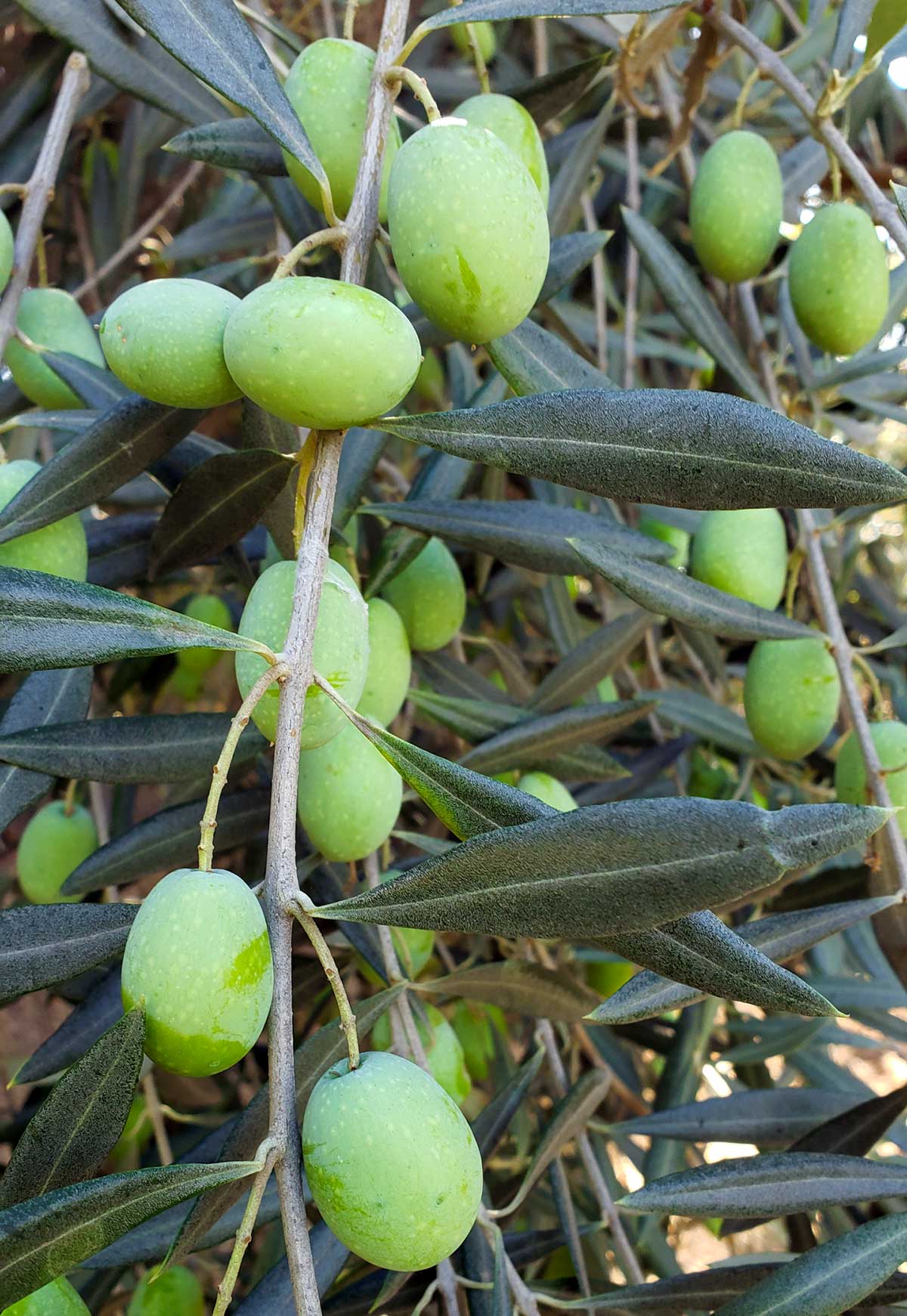
You can buy fresh olives online, and over the years I have provided links, but these companies seem to come and go quickly, so I don’t do that anymore. Just Google “buy fresh olives” around September here in the United States, and I think March in Australia.
The timing is important because you want fresh green olives. And yes, like peppers, all olives start green and ripen to another color, usually black in the case of olives.
Green, unripe olives are firmer and way more astringent than ripe ones. Brining olives when they are green is a great way to cure them, and green olives are the only olives suitable for what, admittedly, is my favorite cure, which a lye cured olive. That process, believe it or not, has been used for 2000 years, and is not as scary as it sounds.
You can brine ripe, black olives, too, just so you know.
My general rhythm is to cruise my local parks in late September or early October; they are full of olive trees, remnants of pre-suburbia orchards around here. On some crisp autumn Saturday, I go picking. Look for pretty olives, with few or no blemishes, and which are not wrinkled.
Tiny dots on an olive are OK, but many may be rotten with olive fly, whose larvae burrow into olives and leave a beige scar where they entered. that telltale scar means there is a visitor lurking within your olive.
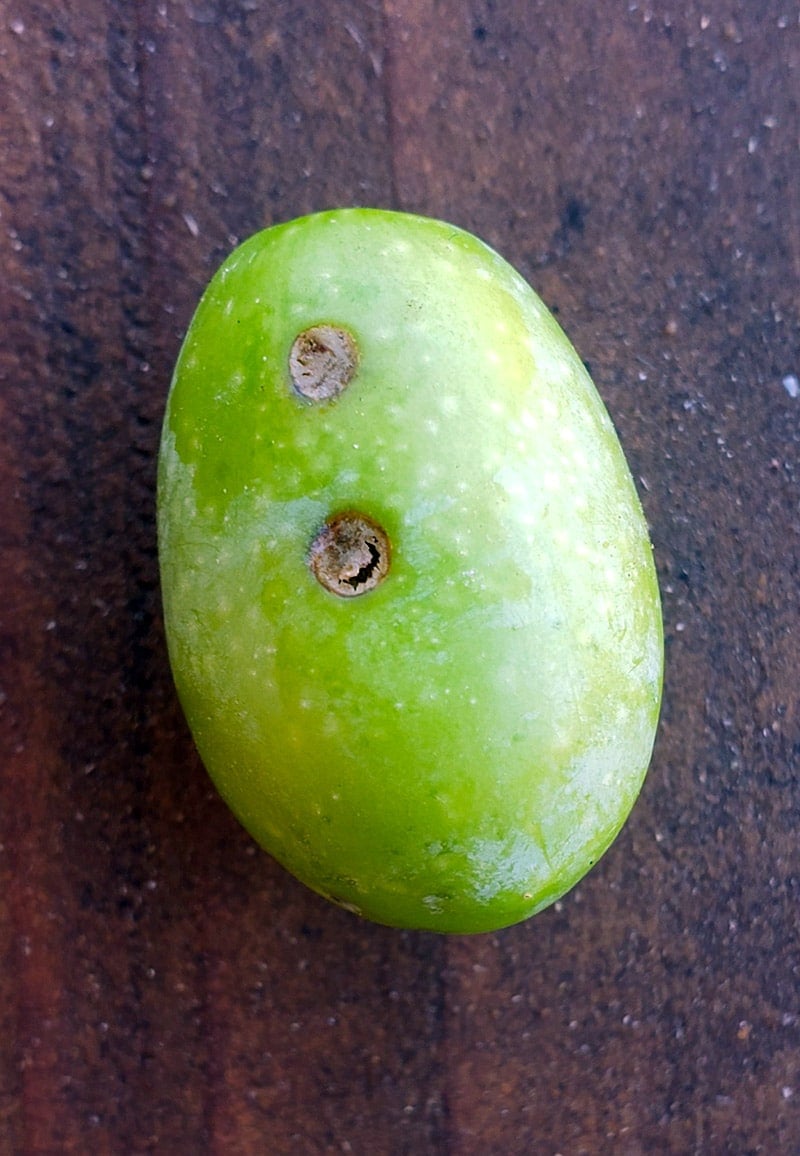
Another hazard are the dry olives. Trees forced to live by their own wits — away from regularly watered grass — are stressed, and their olives shrivel early. Shriveled olives are usable, but they bruise rapidly and don’t make a clean green olive.
When you get home, separate your olives into small, medium and large olives — it doesn’t matter what variety they are, as I don’t know how to tell the difference. If you don’t have enough large ones to make its own batch, mix them with the mediums.
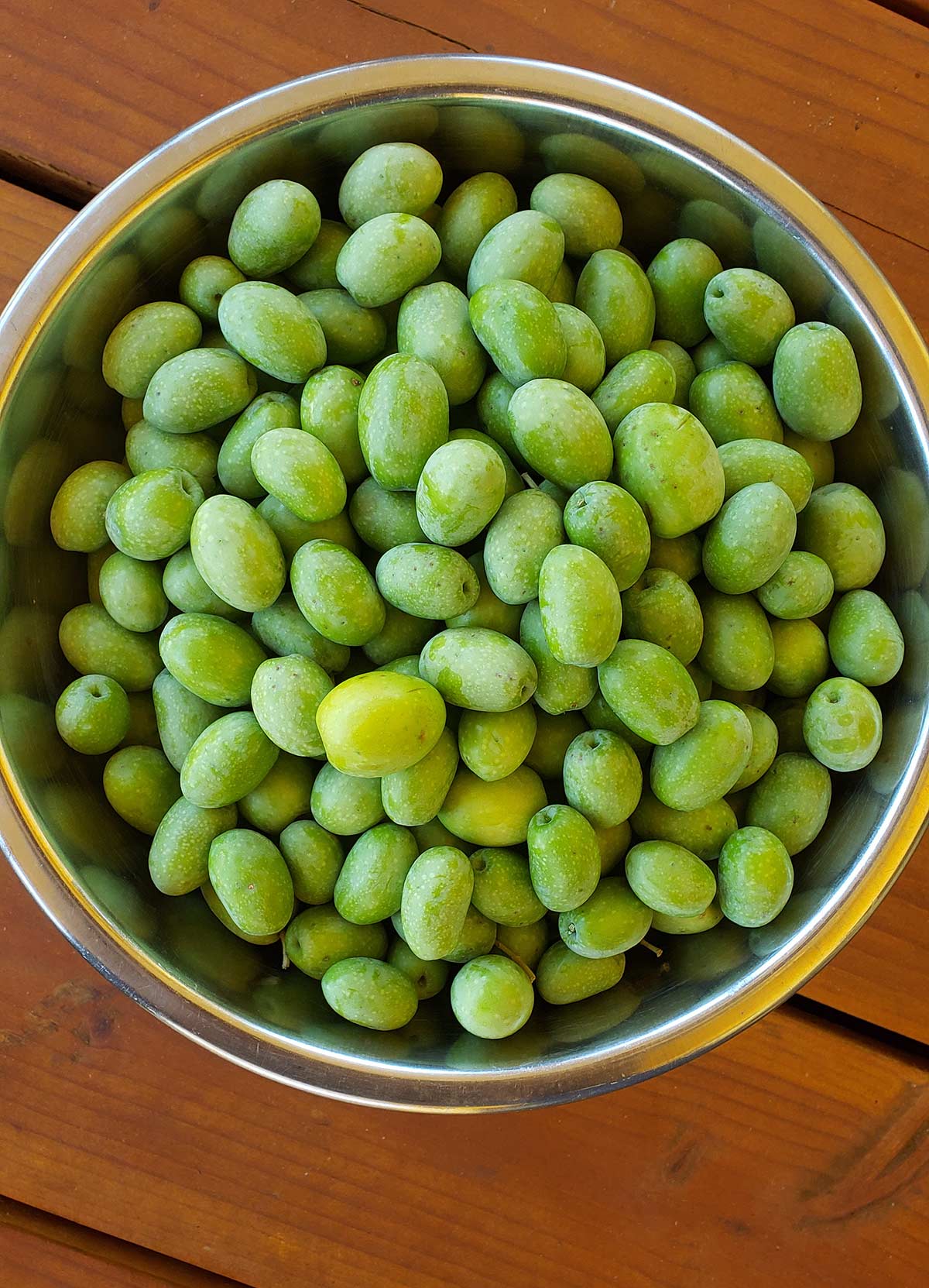
Unless I am doing the lye cure, brining olives is my preferred method, as it is low-maintenance and results in a super-tangy, salty olive that keeps for more than a year and cries out for beer or ouzo. And I like ouzo. A lot.
Brine-curing is easy, but takes a long time. You make a brine of 1/4 cup kosher salt (I use Diamond Crystal) to 4 cups water, plus 1/2 cup of vinegar: white wine, cider or simple white vinegar. Submerge the olives in this brine and top with cheesecloth or something else to keep them underwater. Do not cut them.
Cover the top of the container loosely (I use large, 1 gallon glass jars) and put the jar in a dark, cool place. That’s it. Check it from time to time — meaning every week or so at first. The brine should darken, and you might get a scum on the top. That’s OK.
What’s going on is that your olives are fermenting; it is the fermentation that breaks down the oleuropein over time. The what? Yeah, oleuropein is the astringent substance in an unripe olive. It needs to go if you are going to eat one. Fermentation is why I never wash my olives before curing — I want those natural yeasts on the outside of the olive to do their magic.
I change my brine every month or two, when it begins to look extra nasty. I don’t re-rinse the olives, during changes, either, because I want the residue to act as a “starter” to get the next batch of brine going.
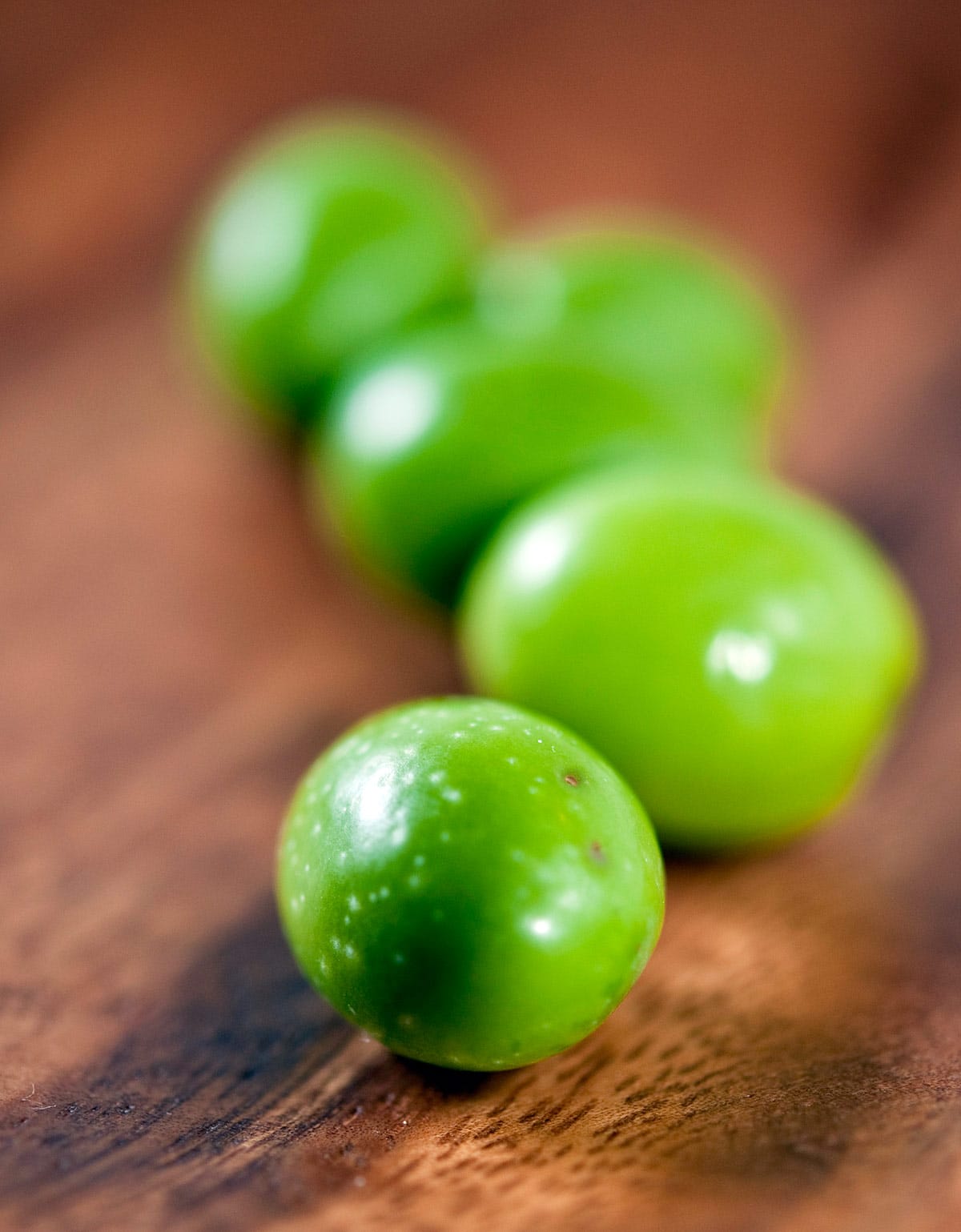
Keep in mind you will be in for the long haul: Olives picked in October are typically ready to eat in May or June. It’s a lot like making wine.
Add seasonings after the New Year, or even later, otherwise you risk too much spice and not enough olive flavor; this is especially true of chiles. If you find you’ve gone too far, change the brine and don’t add new seasonings, and let it steep for a few weeks. That should calm things down a bit.
Once the olives are finished, there is a certain show-off factor when you pull out a plate of olives you cured yourself. “These are your olives? Wow.” Plus, you can flavor them any way you like, which is a bonus.
If you’re too late for green olives, I really like salt cured black olives, which we all call oil-cured olives since that’s how they are stored. If you want to cure black olives, my method is to oil-cure olives.
Brine Cured Green Olives
Ingredients
- 4 pounds fresh green olives
- 1 cup kosher salt
- 1 gallon water
- 1 cup distilled vinegar
Instructions
- Assuming you've already checked your olives for worm scars (see headnotes), discard any with too many blemishes. Place the olives in a stoneware crock or large glass jar with a lid carefully. Fresh olives actually do bruise easily.
- Mix the vinegar, salt and water together. No need to boil, as it will dissolve at room temperature. Pour this over the olives, making sure they are submerged by at least 2 inches. Add more brine in the same ratio if need be.
- Chances are the olives will float. You need to keep them away from air, so I put a plate over them that is just about the size of the jar or crock. You can also use a plastic bag filled with water to keep the olives away from air. Once the olives are submerged, cover the jar or lid (lightly screw on the top if there is one) and place the container in a cool, dark place. A basement is ideal. You don't want them to ever get beyond 75°F if you can help it, because at higher temperatures the olives can go soft. Since this is a wintertime cure, it should not be a problem. Low temperatures are fine, just don't let them freeze. Let them sit for several months.
- As time passes, you will see a scum of mold and weirdness form on the top. This is normal. Skim it off once a week and you'll be fine. At some point the brine itself will get pretty icky. I like to change the brine every month or so, but this is not strictly needed. The olives are done when they are no longer bitter, anywhere from 2 to 4 months.
- Only now do you add other seasonings, like chile peppers, black peppercorns, herbs or citrus peel. Do this in a fresh brine, and let this new, flavorful brine sit 2 weeks before serving. Store the olives in this brine, in a cool place or refrigerator, for up to 2 years. I keep them in quart Mason jars.
Notes
Flavor Additions
- dried chiles
- bay leaves or similar aromatic leaves like citrus leaves
- thyme, sage, oregano, rosemary
- allspice, black peppercorns, juniper berries
- smashed garlic cloves
Nutrition
Nutrition information is automatically calculated, so should only be used as an approximation.

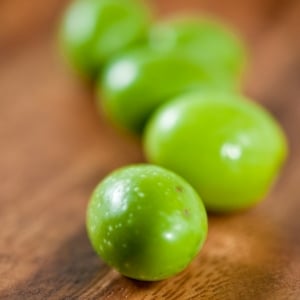




Julia: You will not find them until late September or early October. I have heard several people say you can order them from good Italian groceries. I’ve also heard that they can be had at places like Agata & Valentina. But they have a short season. Start asking around Sept. 15.
hi all, i know this is an old post but i am having no luck finding a place near NYC or online that sells raw, uncured olives. can anyone point me in the right direction?
thanks,
Julia
Hi Hank-
I picked a bunch of green olives last November and started them in the brine cure. The problem is that I had forgotten about them since and just found them. There was quite a bit of mold on top but the brine looked okay. The olives look a but darker than your picture but other than that, okay. I guess I am just asking what, if anything, I should do from here. Would it be safe to rinse and try them?
Thanks in advance.
Ed
I am thinking abiut planting one manzanillo olive tree in mid Alabama. Would one tree produce enough fruit to make it worth my while. Also would Manzanillo be a good choice?
Hello again. I started brine curing some very light green (like your fresh photo) olives in mid-November. The olives are now very very dark green / brownish. You mentioned that your brine cured green olives ended up looking like the lighter cured olives in the photos above. Mine look much more like the darkest. Is this a problem? Anything I should look for that will tell me these olives have gone bad? Thank you in advance for your help. -Denise
Great article! And very nice photographs! My favorite article of all I’ve found online….
I live in the wine country and every year, I saw the olives in front of my house and in the nearby wineries go to waste. So this year, I decided to make use of them. I picked them a bit too late, in January. They’ve been in brine and now taste salty but not bitter. So today I am going to put them in olive oil and herbs. Can’t wait to enjoy the fruits of my labor.
Thanks so much for this great post. I just ordered 25 lbs of organic olives and was searching for brining/preservation tips. I think I’m going to try 3 different methods from the UC Davis article. Cheers.
Hye I did 1 mo in plain water as directed and now a month in brine with seasoning etc and now they are all mushy. The skin is tough and the inside are falling apart. I started a new batch a month ago in just water, and those seem to be getting mushy also. I have two crocks that I used and there was mold on the top, which I scooped off.
What did I do wrong?
Dee: I rinse out the old jar and reuse it. No real cleaning needed, just a quick rinse.
When you change the brine do you put the olives in a clean jar? Or do you rinse out the old jar? Or do you just leave it in the same jar without doing anything?
Thanks so much!! This post has been so helpful 🙂
Sweet post! The Youtube videos confused me a little.
We have an Italian cash&carry, in Rochester NY, with 16lb cases of green Sevillano olives for $6. I guess it sounds a little late in the season. They are La Conda brand from California.
I bought two. Trying (slit) fresh water on one case and brine on the other. Lye scares me a little, though I would consider an ash cure. This is my first attempt(s) so I’ll keep it simple
I’ve never met an olive I didn’t want to eat. I remember sampling a tiny one off the tree in a Tucson courtyard and wishing I hadn’t.
Anyway, thanks for the post and years of follow-up.
Kevin
I have been soaking my 32 pounds of olives for 1 month , it is not Dec 15th. I m so excited this is my first time. we are italian and my stepfather did this years ago and I also wanted to do it so now I am at age 55! I love the process you choose. thank you so much! I hope they come out yummy. Merry Xams!
cherylanne
We moved 2 years ago to a property with Olive trees. Last year we did not have fruit, but this year it’s huge so we started to read, and found your blog. I have a few old brining pots so used them and I’m now into the salting stage on the green olives. Now you mentioned the December ripe olives, but I don’t see any recipe for them. I have a small handful that I need to do something with.
Denise: No and no. I don’t split my olives before brine curing and I don’t wash them, although some people do. I find I get a better flavor when the natural yeasts and beasties on the olive skin get a chance to play.
Once I am done curing I seal the jar and I do not keep changing the brine. If it gets nasty, of course, you can change it if you’d like. I tend to do this when my olives are more than a year old.
Flavia: Look up UC Davis Extension. They have a whole pamphlet on dealing with olive fly. You need to set out traps in February, I think.
Elaine: Don’t screw the top on, as you want gases released by the fermenting olives to get free. After about 6-8 months you can tighten it up.
I know this post was over a year ago… but I have a question that might sound silly. With the brining method you mentioned last… you said cover the top of the jar “loosely” I have a jar with a screw on top. Can I just screw on the top? Or should it be looser?
Hank thanks for your website – I have 20 pounds of olives I purchased water curing. On a different note, I live in So Cal and we have an olive tree in our front yard, it is 50-60 year old tree, we have been unable to harvest because of the olive fly! Do you know of any methods used to get rid of this pest!!
A couple more things…if you are still checking this post. I know I’m a little late in the game.
1) I see you cover the jar of brine-curing olives “loosely”. Do you actually seal the jar at some point (after seasoning?) or does it stay unsealed the entire time, until you’ve eaten all of the olives. I have a large glass jar w/ rubber seal. I began brine-curing tonight and just rested the glass lid atop the jar without the rubber seal.
2) Once you add spices/seasoning (after the New Year) to the brine-cured olives, do you discontinue changing the brine?
Thanks again!
Hi Hank,
Two quick questions.
1) Did you split your brine-cured olives before curing?
2) Did you wash your olives before brine-curing (it seems that’s a no, but want to confirm)?
Thanks!
Denise
Hank,
Thank you for this great article. I live in Arizona and picked a gallon jar of olives about the first week of October. I mixed up the salt brine and have the olives stored on a shelf in the closet. It has been right at a month now and I still haven’t any fermentation going on. At least that I can see. I feel I have the correct measurements of the ingredients. In your article it says to change the brine monthly. Does this sound normal to you? Thanks for your advice.
Thank you!